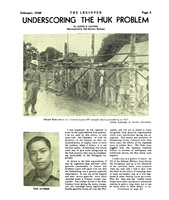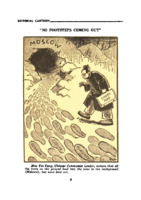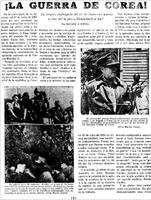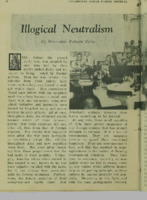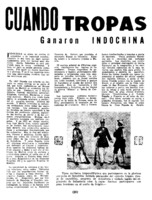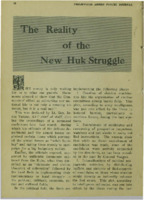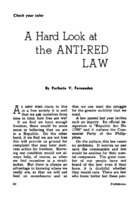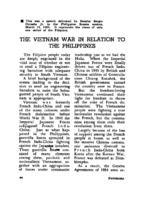A defense of the HUK
Right after the Second World war ended, tensions between the U.S. and its former ally, the Soviet Union, led to another global conflict on a local scale, the Cold War (1947-1989), which intertwined ideological, economic, social, and military conflicts in interacting global and regional scales (Halliday 1994, 98).
The legacies of the past conflict, out of which the cold war partially originated, were urgent in the Philippines: the persecution of Japanese war crimes and collaborators and the Hukbo ng Bayan Laban sa Hapon (“People’s Anti-Japanese Army”) or Huks, the militia of the Partido Komunista ng Pilipinas (PKP), which was mobilized and armed during the Japanese occupation. As Vicente Rafael (2000, 114) argues, collaborationists were mostly pardoned after Manuel Roxas (1946-1948) won the first presidential election of the newly proclaimed Republic of the Philippines and issued a general amnesty in 1947, which, together with the restitution and deepening of social inequality via legal and violent enforcement (Kerkvliet 2002, 249-69), arose social tensions.
Editorial cartoon on the Soviet threat
President Quirino (1948-1953) essentially continued Roxas’s foreign policies, although he sought more comprehensive security arrangements with other Asian countries and more concrete American compromises of assistance (Jose 2012, 34-35), especially after the Communists gained control of mainland China and established the People's Republic of China (PRC) in 1949. Quirino also neglected land reform while granting US parity rights to own land, and the HUK conflict escalated to a civil war between 1947 and 1956, getting close to seizing Manila (Deocampo 2017, cap. VIII).
As a reaction to these tensions, in 1950, the Philippine congress created the Committee on Anti-Filipino Activities to investigate and suppress radicals and communist sympathizers (Jose 2012, 36). Paranoia of communist infiltration grew especially after the release of Ako raw ay Huk, a film advertised in the UPD collection which, as Nick Deocampo (2017, cap. VIII) argues, inaugurated an interventionist and war-like approach in media.
Although the bulk of the Philippine Armed Forces was preoccupied with HUK insurgents (Sen 2005, 86), the Philippines was one of the first countries to show unity with the USA in the Korean War (1950-1953) and sent one battalion (Cullather 1993, 318), the 14th BCT “Avengers”, probably in an attempt to bring a friendlier attitude in the US Congress towards clearer commitments with the Philippines (Jose 2012, 36, 41). US President Truman finally backed the government with supplies, helping break the insurgent HUK, and signing the Mutual Defence Treaty in Washington on 30th August 1951.
On the Korean War and anti-Communism
The UPI collection holds several articles on the Korean War, both in English and Spanish, condemning the North-Korean aggression and comparing the conflict with WWII. Semana published an interesting report on the war in Spanish by Rafael S. Ripoll and directly after the armistice on July 27, 1953, the Philippines Armed Forces Journal would publish several illustrated reports of army officers that took part in the conflict, such as Colonel Nicanor Jimenez, 5th commander of the “Avengers”, Captain Robert Anstey (QMC, U.S. Army), who praised the remarkable record of Filipinos avoiding injuries induced by cold weather-conditions; and Brigadier general S.L. Marshall’.
1953 ended not only with the armistice but also with the electoral triumph of president Ramon Magsaysay (1953-1957), who won back popular support after a series of measures already enacted by Quirino had a deadening effect on the Huk movement (Kerkvliet 2002, 255). In 1954, Huk leader Luis Taruc surrendered and the rebellion came to an end. Nevertheless, Jesus Lava continued with the guerrilla in Pampanga until his detention in 1964, also pictured in the UPD collection.
Later on, Magsaysay joined the Southeast Asia Treaty Organization (SEATO) established on 19 February 1955 (Sen 2005, 86), the alliance Quirino had hoped for. The UPD collection shows how the end of neutrality was celebrated as the only to defend Filipino independence and democracy in front of both western colonialism and communism, especially after North Vietnam's and North Korea’s military building up. Nevertheless, it did not provision automatic retaliation and tied the Philippines even more to U.S. foreign policy (Jose 2012, 40).
On Spanish and Filipino involvement in the French imperialist advanced in Vietnam
Due to this alliance, the Philippines became involved in the Vietnam war (1955-1975) (Sen 2005, 86). The conflict in the region was an issue since the First Indochina War (1946), in which the Philippines did not intervene due to its colonial overtones. Semana had followed the events since the Indochina War of 1954. After the Geneva Conference (26 April to 20 July 1954), which settled the Korean War and the First Indochina War by dividing both territories into two countries, Semana attacked Communist Vietnam in August 1954 in a series of articles. One article from August 19, 1954 even celebrated the joint intervention of the French Empire and the Kingdom of Spain in 1857, which brought French colonialism and western civilization to Indochina, now dangered by Communism.
A hard look at the anti-red law
These fears were fueled by a rise in insurgency activity after 1955, resurrected by the Philippines' involvement both in Korea and Vietnam and the issues regarding US bases in the archipelago, which drained again the country's military capabilities (Jagel 2013, 22). The Philippines Armed Forces Journal was especially harsh on this “new huk struggle”, claiming that “the enemy is only waiting for us to relax our wards”. In 1957 President Carlos P. García (1957 – 1961) passed the Anti-Subversion Act, officially Republic Act No. 1700, which outlawed the Communist Party of the Philippines of 1930 and the Hukbalahap. As the UPI collection shows, this measure divided public opinion between those who saw the measure as necessary and the ones that saw it as a reduction of civil rights.
García also signed a friendship treaty with the new Republic of Vietnam, but Diosdado Macapagal (1961-1965) got involved in the conflict, sending sixteen doctors, nurses, technicians, and civic action officers to Vietnam on 16 August 1964, and an additional contingent of sixteen officers in mid-January 1965 (Jagel 2013, 23-25). After the Cuban Missile Crisis of October 1962, a key moment in the world conflict, which almost provoked a nuclear war (Stern 2005), President Lyndon Johnson (1963-1969) tried to involve other Asian nations in the conflict (Cullather 1993, 318) and pressure from the American side increased, as the English-speaking Sunday magazine Panorama shows. Nevertheless, the US did not want to fund all the contingent and the 2,000-man task force remained strongly under debate (Jagel 2013, 25-26).
The Vietnam War in relation to the Philippines
It was not until the summer of 1966 that the Philippine Civic Action Group (PHILCAG) began to arrive in Vietnam (Jagel 2013, 28-30), but their numbers would only drop after 1967 (Jagel 2013, 32-38). As Jagel (2013, 39) puts it, American diplomatic pressure, which got PHILCAG into Vietnam, was proof that America did not support Philippine aspirations and that the country needed an independent foreign policy distancing the country from the U.S. By November 1969, PHILCAG retired from Vietnam (Jagel 2013, 39-41) and the Philippines would not intervene anymore in a Cold War that was not its own anymore.
Bibliographic references
Cullather, Nick. 1993. "America’s Boy? Ramon Magsaysay and the Illusion of Influence", Pacific Historical Review 62 (3): 305-38.
Deocampo, Nick. 2017. Film: American Influences on Philippine Cinema. Anvil Publishing, Inc.
Halliday, Fred. 1994. Rethinking International Relations. Macmillan Education UK.
Jagel, Matthew. 2013. "'Showing Its Flag': The United States, The Philippines, and the Vietnam War", Past Tense: Graduate Review of History, 1.2, July.
Jose, Ricardo T. 2012. "The Philippines’ search for security in the first years of the Cold War, 1946-51", in Southeast Asia and the Cold War, 47-60. Routledge.
Kerkvliet, Benedict J. 2002. The Huk rebellion: A study of peasant revolt in the Philippines. Rowman & Littlefield Publishers.
Sen, Rabindra. 2005. "Philippines-U.S. Special Relationship: Cold War and Beyond", Jadavpur Journal of International Relations 9 (1): 85-92.
Stern, Sheldon. 2005. The Week the World Stood Still: Inside the Secret Cuban Missile Crisis. Stanford Nuclear Age Series. Stanford University Press.
Stueck, William. 2002. Rethinking the Korean War: A New Diplomatic and Strategic History. Princeton University Press.
Woods, Colleen. 2020. Freedom Incorporated: Anticommunism and Philippine Independence in the Age of Decolonization. Ithaca: Cornell University Press.


